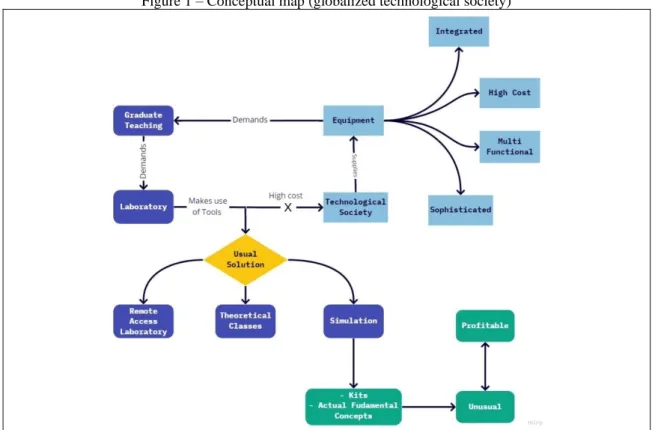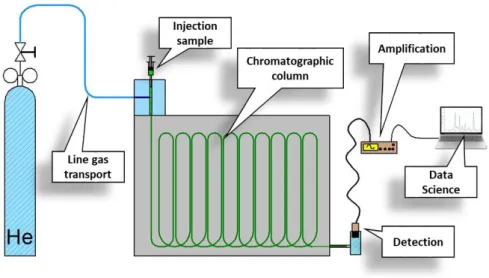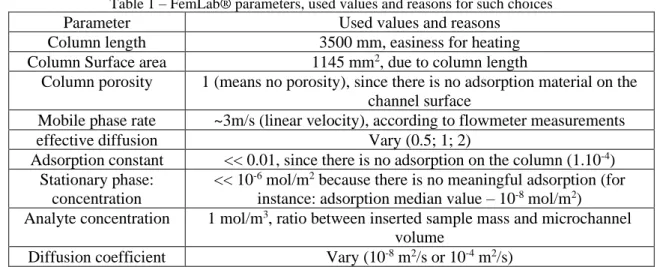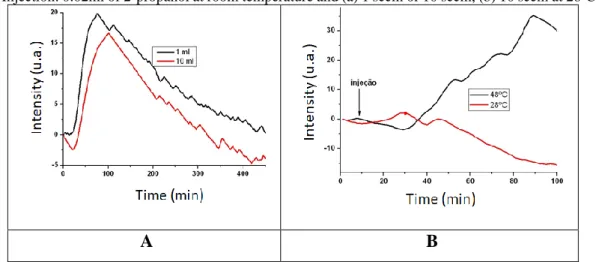Braz. J. of Develop.,Curitiba, v. 6, n. 10, p.81696-81711, oct. 2020. ISSN 2525-8761
Correlation between Simulations and Experimentation: Simple Approach for
Technological Teaching
Correlação Entre Simulação e Experimentação: Abordagem Simples Para o
Ensino Tecnológico
DOI:10.34117/bjdv6n10-556
Recebimento dos originais: 13/09/2020 Aceitação para publicação: 26/10/2020
Walter Pichi jr
Prof. Dr. em Ciências, PUC, SP ETEC - São Paulo, CPS
Endereço: Av. Tiradentes, 615 - Bom Retiro, 01101-010, São Paulo, SP E-mail: Jrww01@gmail.com
Roberto da Rocha Lima Ph. D. Eng. Elétrica, USP Instituto de Física, USP
Endereço: Rua do Matão, travessa R, 187 - Butantã, São Paulo - SP, 05508-090 E-mail: rrlima@if.usp.br
Leonardo Frois Hernandez Ph. D. Eng., USP
Faculdade de Tecnologia de São Paulo, CPS
Endereço: Av. Tiradentes, 615 - Bom Retiro, 01101-010, São Paulo, SP E-mail: leolfh1@fatecsp.br
Maria Lúcia Pereira da Silva Ph. D. Físico-Química, USP
Escola Politécnica, USP e Faculdade de Tecnologia de São Paulo, CPS Endereço: Av. Prof. Luciano Gualberto, 158 - Butantã, São Paulo - SP, 05508-010
Braz. J. of Develop.,Curitiba, v. 6, n. 10, p.81696-81711, oct. 2020. ISSN 2525-8761 ABSTRACT
Technological education requires high-cost equipment that, in most cases, does not favor a good understanding of the phenomenon occurring during its use. A possible solution is simulation; however, without the corresponding experimentation, it does not contribute for elucidation of real problems when using such equipment. A critical problem for Chemical Engineering and Chemistry is heating of fluids in small dimensions, as occurs in chromatographic columns and distillation tower. Therefore, this work aims the manufacturing of a prototype and corresponding simulation, for such learning process. The obtained product was manufactured with low-cost materials and conventional machining instruments. Simulation used FEMLAB® program and was carried out in 1D. The device is miniaturized and suitable for classroom demonstrations. Moreover, it allows an easy understanding between temperature programming and the corresponding chromatographic peak profile, essential parameter in performance measurement. Thus, simple ways of manufacturing were developed with low costs but accurate equipment.
Keywords: Engineering teaching, Fluid interaction, Miniaturization, Chromatography, Distillation.
RESUMO
O ensino tecnológico demanda equipamentos de alto custo e que, na maioria das vezes, não facilitam a compreensão dos fenômenos que ocorrem durante o seu uso. Uma solução possível é a simulação que, sem a correspondente experimentação, não contribui para elucidar os problemas reais da utilização destes equipamentos. Um problema crítico para a Engenharia Química e a Química é o aquecimento de fluidos em pequenas dimensões, como ocorre em colunas cromatográficas e de destilação. Portanto, o objetivo deste trabalho foi criar um protótipo e correspondente simulação, para tal ensino. O produto obtido foi produzido com materiais de baixo custo e equipamento convencional de usinagem; a simulação utilizou o programa FEMLAB® e foi feita em 1D. O conjunto é miniaturizado e adequado para o uso em demonstrações em sala de aula; além disso, permite compreender facilmente a relação entre a programação de temperatura e o perfil do pico cromatográfico, parâmetro essencial na medida de performance. Assim, desenvolveram-se meios simples de construção de equipamentos baratos, mas com boa precisão.
Palavras-chave: Ensino em engenharias, Interação de fluidos, Miniaturização, Cromatografia, Destilação.
Braz. J. of Develop.,Curitiba, v. 6, n. 10, p.81696-81711, oct. 2020. ISSN 2525-8761 1 INTRODUCTION
On the 3rd millennium, a new era - named by some people as Infoera [1] and others as Anthropocene [2], emerged. This era brought a globalized technological society that, as shown in Figure 1, uses and/or supplies advanced instruments. These new equipment are not only multifunctional and sophisticated but also costly and highly integrated tools. Another unquestionable change brought by this new era is the need for higher education, highly specialized one, in order to produce or use these new tools [3]. Therefore, the use of expensive machinery, in highly specialized labs, for higher education is an actual need; nonetheless, due to the high cost of such tools, most of the time only theoretical classes are provided.
Nickerson [4] suggests three main attitudes to face that needs: use of real laboratories, laboratory simulations and an intermediate situation, with laboratories accessed remotely. As already pointed out, the first case means high costs, although there is the advantage of direct contact with the object of study in addition to all the parameters to adjust and the unexpected possibilities of a real problem. Simulation requires less infrastructure with lower costs; besides that it is easier and quicker, since on real conditions (laboratory or field) a great amount of time is spent on instrumentation optimizing rather than on experimentation. Remote access to laboratories, due to the share of infrastructure among several users, reduces costs and enables knowledge of real situations [5,6].
An intermediate solution between simulation and actual labs is educational kits. However, teaching the fundamental concepts using this approach is tricky; therefore, this work proposes another perspective: focus on the actual phenomenon, i.e. the real concepts to be taught and develop the correspondent device. Although unusual, this approach could be more profitable from an educational and financial perspective. Due to the relevance of fluid mechanics and instrumental analysis to Chemical Engineering and Chemistry, respectively, this work focuses gas chromatography.
Braz. J. of Develop.,Curitiba, v. 6, n. 10, p.81696-81711, oct. 2020. ISSN 2525-8761 Figure 1 – Conceptual map (globalized technological society)
2 FUNDAMENTAL 2.1 GENERAL
As pointed out in the introduction, even with the use of sophisticated equipment, technological education presents some drawbacks, since such equipment is usually highly integrated, which does not allow access to the modules that compose it. Therefore, educational kits are an useful solution, not only on elementary but also in higher education [7, 8, 9].
High school and college freshmen students are also usually exposed to these kits with the didactic approach of hands-on teaching [10]. In this case, the commonest goal is the STEM (Science, Technology, Engineering and Mathematics) field. These efforts contemplate from simple experiments to complexes devices, some of them virtual [11] others even multifunctional [12]. However, even now the process of teaching fluid mechanics presents some idiosyncrasies. For instance, Huilier [13] reviewed the last 40 years on fluid mechanics teaching in France and states that “the challenge will be to apply innovative teaching methods to fluid mechanics, based on a learner-centered teaching approach, in order to foster students’ motivation to learn about fluid engineering”. In a similar way, in the USA [14], curriculum on such topic has faced some challenges, especially with millennials, since this population, among other things, is multitask and highly connected. On the other hand, unexpected solution that mixes miniaturization and remote access [15] prove to be a useful tool. Nonetheless, the process of teaching classical mechanic fluid
Braz. J. of Develop.,Curitiba, v. 6, n. 10, p.81696-81711, oct. 2020. ISSN 2525-8761
concepts does not attempt to some concealed needs for instrumental analysis or chemical engineering unit operations, since it is difficult to observe, even in a demonstrative class, the operation of the instruments and their “inner” structures.
2.2 GAS CHROMATOGRAPHY
An emblematic example of the difficulties described previously, is the process of teaching chromatographic concepts. Chromatography is a process for separating complex mixtures and it is equally important for chemical analysis and for the extraction of compounds from a sample. Despite the controversies about the beginning of the technique [16-18], Grob points out that records dating back to 1834 shows the extraction of pigments presents on plant extract using fabric as a support [19]. Up to now, pigment extraction is highly dependent on the chromatographic techniques.
Currently, the chromatographic technique is widely disseminated and presents a wide variety of equipment; however, in general the main concepts can be taught through gas [19] and liquid chromatography [20], although von Mühlen and Lanças [21] consider that in both cases the operating principles are the same.
The equipment used for such analyzes is extremely accurate and also very complex, on the other hand, although some less expensive instruments can be used with high school and freshman students [22], the commonest approach is based on the use of simple materials and common glassware in chemistry labs [23]. These experiments, although quite useful, since they actually demonstrate separation of some compounds, they do not outline relevant issues present in the equipment, such as heating and/or transporting fluid in a microchannel. Heating on small dimensions is the core idea for capillary gas chromatography and it is similar to the need for separation on distillation towers, packed or miniaturized [24]
3 MATERIALS AND METHOD 3.1 METHODOLOGICAL STEPS
As mentioned earlier, the core idea for Chromatography and Distillation is heating in small dimensions; thus, a prototype for handling of heated fluids in microchannels was developed and its simulation to explain the obtained results was carried out.
Prototype design: For the construction of the prototype it was considered that a capillary gas chromatograph consists of some blocks, depicted in Figure 2. In a commercial system, a gas cylinder provides the gas flow, which is kept constantly by means of a flowmeter. Then, the gas is admitted to a capillary whose surface is modified to allow selective adsorption of a class of compounds. This
Braz. J. of Develop.,Curitiba, v. 6, n. 10, p.81696-81711, oct. 2020. ISSN 2525-8761
capillary is called a chromatographic column and in general has a diameter of less than 100 µm and a length of more than 10 m. The sample analysis is inserted immediately before the column using a latex septum and a microliter syringe. The column is in an oven and its temperature can be varied but must be carefully controlled. A detector is positioned immediately after the column and records the chromatogram, i.e., detector signal as a function of time. Therefore, there must be a sensor capable of detecting the analyte present on the sample. In the present case, the developed device corresponds to the chromatographic column and temperature control oven, with its respective profile. The gray area in Figure 2 depicted the developed device. The other necessary components for turning the prototype into an operational tool can be used from any commercial apparatus that provide regular flow and sensitive detection of the reactants used on the experiment. In this work it was used from equipment previously developed [25], whose scheme is depicted in Figure 3.
Figure 2 - Blocks diagram. Scheme of a gas chromatograph
Prototype boundary conditions: as shown in Figure 3, air can be propelled in a flow meter using an aquarium air pump. Therefore, this work used as the carrier gas atmospheric air without any previous treatment. Furthermore, the detector corresponds to a low in cost tin oxide sensor, which allows the detection of volatile organic compounds (VOCs) on ppm range.
Braz. J. of Develop.,Curitiba, v. 6, n. 10, p.81696-81711, oct. 2020. ISSN 2525-8761 Figure 3 - Blocks diagram. Equipment used to test device modules [25].
Regarding the device, the microchannel, sketched in Figure 4A, was machined in 316L stainless steel and it is 100 µm wide, 40 µm deep and 3.5 m long. The channel total volume is 10.5 µL and total area is 1145 mm2, i.e., the area/volume ratio is 110. There is no film deposition on the surface and the temperature control in this channel is done at three different points - beginning, middle and end - by means of thermocouples. For sample insertion/removal, capillaries were positioned at the beginning and end of the structure, respectively. These capillaries were welded using high vacuum resin (TorrSeal - Varian Vacuum Technologies). A resistance, positioned in the center of the machined stainless steel block, favors a homogeneous heating of the channel [25].
The column is kept isolated from the environment by encapsulation in Celerol®, which also provides mechanical support. Figures 4B and 4C show images of the column and the device itself, respectively.
Figure 4 – Device: (A) Blocks diagram. Photos: (B) column and (C) whole structure
Braz. J. of Develop.,Curitiba, v. 6, n. 10, p.81696-81711, oct. 2020. ISSN 2525-8761 3.2 MATERIALS AND PROCEDURES
The simulation used the FEMLAB 3.1® program (free version1).
The sample was injected with disposable syringe (0.5 mL total volume).
All required materials for device manufacturing are on-shelf goods and can be easily found on the market. Microchannel manufacturing can be carried out using mechanical lathe.
This work uses principles of Green Engineering, which means the reactants are environmentally correct and used in small quantities; therefore, can be discarded without any treatment.
4 RESULTS AND DISCUSSION
4.1 PRELIMINARY CONSIDERATIONS
In a capillary gas chromatography column, the film deposited on the capillary surface, called stationary phase, promotes sample adsorption whereas a gas flow, called mobile phase, carries the sample. Furthermore, the sample separation depends on the interaction that occurs between the components of the mixture and the stationary phase due to these mainly two parameters: solubility and volatility. Thus, the greater the solubility of the component in the stationary phase, the slower it travels through the column; on the other hand, the more volatile, the faster its exit. Another important parameter is the random movement of the sample in the channel (eddy diffusion), which means longer sample resident time in the column higher diffusion. The sum of all these processes generates an approximately Gaussian profile at the output.
The analysis of these Gaussian profiles provides several important insights about the sample and equipment. For instance, longer sample resident time in the column, broader Gaussian profile, and consequently “less intense” peaks on the detectors, i.e., higher detection limit. In order to decrease diffusion, analysis time rarely exceeds half an hour, even for complexes samples, such as fractions of petroleum [26]. Therefore, a way to favor the output of a component that has high affinity for the mobile phase and/or low volatility is by using controlled heating of the column, which makes the heating profile critical to define the performance of the instrument.
Finally, a large amount of sample in the column also favors dispersion. In a previous work, the issue of channel saturation was addressed [27], on the other hand, in this work the surface is not adherent; therefore, with the device it will be evaluated only the behaviors due to the volatility of the sample components and their random diffusion. Nonetheless, this information is of paramount importance for the understanding of chromatography and also distillation.
Braz. J. of Develop.,Curitiba, v. 6, n. 10, p.81696-81711, oct. 2020. ISSN 2525-8761 4.2 SIMULATION
The FEMLAB® program allows the simulation of the concentration profile of a component in the column as long as some parameters, as shown in Table 1, are provided. This table also depicts not only the chosen parameters but also the reasons for this choice. Two parameters are quite meaningful, effective diffusion and diffusion coefficient, since they were varied to simulate volatility and eddy diffusion, respectively. In the program, the effective diffusion has normalized values, where “1” corresponds to the most common condition in chromatography. Although, higher reactant volatility means higher diffusion, in gas phase most volatile organic compounds have a diffusion coefficient of 10-8 m2/s [28], but can reach up to 10-4 m2/s if an external condition favors dispersion (rapid heating and so on) [29]. The column residence time was fixed up to 180 s compatible with experimental values.
Table 1 – FemLab® parameters, used values and reasons for such choices
Parameter Used values and reasons
Column length 3500 mm, easiness for heating
Column Surface area 1145 mm2, due to column length
Column porosity 1 (means no porosity), since there is no adsorption material on the
channel surface
Mobile phase rate ~3m/s (linear velocity), according to flowmeter measurements
effective diffusion Vary (0.5; 1; 2)
Adsorption constant << 0.01, since there is no adsorption on the column (1.10-4)
Stationary phase: concentration
<< 10-6 mol/m2 because there is no meaningful adsorption (for
instance: adsorption median value – 10-8 mol/m2)
Analyte concentration 1 mol/m3, ratio between inserted sample mass and microchannel
volume
Diffusion coefficient Vary (10-8 m2/s or 10-4 m2/s)
Figure 5 shows analyte profile inside the column when the flow reaches half the channel length. Although the volatility favors the widening of the Gaussian profile, which decreases the maximum peak value, i. e, it increases the detection limit (Figures 5A and 5B), heating is more relevant for fluid spreading (Figures 5C and 5D), that is, heating is only justified if sample must be removed quickly from the column.
Braz. J. of Develop.,Curitiba, v. 6, n. 10, p.81696-81711, oct. 2020. ISSN 2525-8761 Figure 5 - Analyte profile inside the column when the flow reaches half the length of the channel.
Effective diffusion of 0.5 (A) or 2.0 (B). Diffusion coefficient of 10-8 (C) or 10-4 (D) m2/s.
4.3 MANUFACTURED DEVICE
The main device function is heating the column in a controlled manner. In a gas chromatograph, the overall temperature ramp is usually wide, ranging from room temperature to 200ºC, and fast, normally 10ºC/min [19]. In addition among steep temperature ramps exist fixed temperature plateaus. Distillation presents similar problems, although temperature ramps used to be less critical. Both cases make use of electronic controls on sealed ovens and coolers and Figure 6 shows a merely illustrative image of expected temperature ramps and consequent chromatogram.
Figure 6 – Profiles: temperature ramp and chromatogram
A B
Braz. J. of Develop.,Curitiba, v. 6, n. 10, p.81696-81711, oct. 2020. ISSN 2525-8761
Consequently, the heart of the device is the column heating, provided by an alumina resistance (Resiluz SA, model 08 08 14356, 150W and 110V) and temperature controller (Contemp SA, CTM 45). These two parts, and the necessary electrical connections, cost US$ 49.00, which satisfies the low costs criterion. However, the use of a simple temperature controller and Celerol® as an electrical insulator has limitations, i.e., the temperature can rise significantly above the desired level before the controller turns off. In a similar way, turn off the heating also does not guarantee reaching the desired temperature, due to the device thermal mass. In order to minimize the mass transfer limitation the device was miniaturized. Regarding the best way for obtaining adequate temperature profile, a parameter study on the programming of the temperature controller was carried out. The solution found was implement changes in small steps, i. e., small time intervals at fixed temperature followed by small temperature ramp. The best profiles obtained are shown in Figure 7, where it is possible to observe number of intervals of 6, 18 and 34 for the rates of 8ºC/min, 6º/min and 3º / min, respectively. Just for comparison, Figure 7D shows the programmed temperature ramp, which would be obtained only in an ideal system. It is noteworthy that no meaningful differences on measurements among sensors positioned along the device were found, which means good uniformity on heating.
Figure 7 – Measured temperature ramps for different number of intervals: (A) 6 [8ºC/min], (B) 18 [6º/min] and (C) 34 [3º/min] and (D) programmed heating. Sensors positioning: sensors 1, beginning, and sensors 2, middle, of the column.
A B
Braz. J. of Develop.,Curitiba, v. 6, n. 10, p.81696-81711, oct. 2020. ISSN 2525-8761
The device performance is limited by the actuator, i. e., the temperature controller, which electrical rectification occurs only once at every minute. This small rate explains the greater variations in linearity of curves with temperature ramp of 8ºC/min, which cannot be minimized by increasing the number of intervals. It is also possible to observe that the dispersion in the temperature values among the three sensors is smaller for smaller temperature ramp. Thus, considering these two important variables, linearity and sensors measurements along the column, the best temperature ramp is 3ºC/. However, that is an unusual value in chromatography; therefore, the temperature ramp of 6ºC/min was chosen as a good performance condition.
Tests on correlation between simulation and measurements in the device were carried out injecting 0.02ml of 2-propanol in a of 1 sccm or at 10 sccm air flow at room temperature and comparing to injection at 10 sccm air flow and 28ºC or 48ºC (Figure 8). As it is shown in the figure, a big dispersion exists in the Gaussian, due to the higher temperature, which is consistent with the simulation results. The greater flow, in turn, decreases the residence time of the fluid and the Gaussian narrower.
Figure 8 – Injection: 0.02ml of 2-propanol at room temperature and (a) 1 sccm or 10 sccm, (b) 10 sccm at 28ºC or 48ºC.
A B
5 CONCLUSIONS
This work has proposed, among other things, to correlate simulation and experimental results, for use in the process of teaching where complexes and expensive equipment become a non-viable option. Although the instrument developed has big performance limitations, the qualitative result obtained is important for teaching the phenomenon occurring in a gas chromatograph and also gives insights on distillation constraints due to temperature controls and profiles.
It is noteworthy emphasize the small amount of educational proposals that contemplate an intermediate situation, in which the process of teaching is given in miniaturized equipment what
Braz. J. of Develop.,Curitiba, v. 6, n. 10, p.81696-81711, oct. 2020. ISSN 2525-8761
brings the appropriate advantage of the cost reduction for purchase and maintenance in addition to the less necessary infrastructure.
Braz. J. of Develop.,Curitiba, v. 6, n. 10, p.81696-81711, oct. 2020. ISSN 2525-8761 REFERENCES
[1] Prebianca, G. V. V., Cardoso, G. L., Finardi, K. R. (2014), “Hibridizando a educação e o ensino de inglês: questões de inclusão e qualidade”, Revista do GEL, v. 11, n. 2, p. 47-70.
[2] Lewis, S., Maslin, M. (2015), “Defining the Anthropocene”, Nature, v. 519, p. 171–180. https://doi.org/10.1038/nature14258
[3] Iliško D. (2019), “Challenges of Education for Sustainable Development at Regional Level”. In: Leal Filho W. (eds) Encyclopedia of Sustainability in Higher Education. Springer, Cham. https://doi.org/10.1007/978-3-030-11352-0_5
[4] Nickerson, J.V., Corter, J.E., Esche, S.K., Chassapis, C. (2007), “A model for evaluating the effectiveness of remote engineering laboratories and simulations in education”, Computers & Education, v. 49, n. 3, p. 708-725.
[5] Babich, A., Mavrommatis, K.T. (2009), “Teaching of Complex Technological Processes Using Simulations Int”. J. Engng. Ed., v. 25, n. 2, p. 209-220.
[6] Marlin, T., Hrymak, A., MacGregor, J., Mahalec, V., Mhaskar, P., Swartz, C. (2007), “A stream in Process Systems Engineering (PSE) in the undergraduate Chemical Engineering Curriculum”, American Society for Engineering Education, n. 2007-79.
[7] Dias, T., Sampaio, P., Matutino, P. M. (2020), "A Portable Lab for the Practical Study of Modern Computer Engineering," XIV Technologies Applied to Electronics Teaching Conference (TAEE), Porto, Portugal, pp. 1-7, DOI: 10.1109/TAEE46915.2020.9163750.
[8] Fuada, S. (2018), “Visible Light Communication Kits for Education, Journal of Education and Training”, v. 5, n. 2, p. 39-49. http://dx.doi.org/10.5296/jet.v5i2.12578
[9] Assante, D., Fornario, C., Sayed, A. E. Salem, S. A. (2016) "Edutronics: Gamification for introducing kids to electronics," 2016 IEEE Global Engineering Education Conference (EDUCON), Abu Dhabi, pp. 905-908, DOI: 10.1109/EDUCON.2016.7474659.
[10] Karkoub,M., Abdulla, S. (2018), “Transformative learning experiences in mechanical engineering through mechatronics: From high school to college International”, Journal of Mechanical Engineering Educ, v. 0, p. 1-29. https://doi.org/10.1177/0306419018781532
[11] Radianti, J., Majchrzak, T. A., Fromm, J., Wohlgenannt, I. (2020), “A systematic review of immersive virtual reality applications for higher education: Design elements, lessons learned, and research agenda”, Computers & Education, v. 147, p. 1037-78. doi.org/10.1016/j.compedu.2019.103778.
[12] Takacs, A., Eigner, G., Kovacs, L., Rudas, I. J., Haidegger, T. (2016), "Teacher's Kit: Development, Usability, and Communities of Modular Robotic Kits for Classroom Education", IEEE Robotics & Automation Magazine, v. 23, n. 2, p. 30-39. DOI: 10.1109/MRA.2016.2548754. [13] Huilier, D. G. F. (2019), “Forty Years’ Experience in Teaching Fluid Mechanics at Strasbourg University”, Fluids, v. 4, n. 4, p. 199. https://doi.org/10.3390/fluids4040199
Braz. J. of Develop.,Curitiba, v. 6, n. 10, p.81696-81711, oct. 2020. ISSN 2525-8761
[14] Choudhury, A. A., Rodriguez, J. (2017), "A New Curriculum in Fluid Mechanics for the Millennial Generation", IEEE Revista Iberoamericana de Tecnologias del Aprendizaje, v. 12, n. 1, p. 48-51. DOI: 10.1109/RITA.2017.2658958.
[15] Starks, J., Hendrickson, F. R., Hadi, F., Traum, M. J. (20170, “Miniaturized Inexpensive Hands-On Fluid Mechanics Laboratory Kits for Remote Online Learning”, Proceedings of the 124th American Society for Engineering Education (ASEE) Conference and Exposition. Paper ID #17941 [16] Weil, H., Willams, T.I. (1950), “History of Chromatography”, Nature, v. 166, p.1000-1001, doi no.:10.1038/1661000b0.
[17] Weil, H., Willams, T.I. (1951), “Early History of Chromatography”, Nature, v. 167, p.906-907, doi no.: 10.1038/167906b0.
[18] Tswett’s, M.S. (2009), “Why was chromatographic adsorption analysis rejected?”, Studies In History and Philosophy of Science: Part A, v. 40, i. 1, p. 57-69, March.
[19] Modern Practice of Gas Chromatography, Eds.: R.L Grob and E.F. Barry, (2004), New Jersey: John Wiley & Sons, Inc., Hoboken. 4th ed.
[20] Snyder, L.R., Kirkland, J.J. (1979), Introduction to Modern Liquid Chromatography, New York: John Wiley & Sons, Inc., 2nd ed.
[21] Von Mühlen, C., Lanças, F.M. (2004), “Cromatografia unificada”, Quim. Nova, v. 27, n. 5, p. 747-753.
[22] Connor, G. P. et al (2019), “Implementation of an Accessible Gas Chromatography Laboratory Experiment for High School Students”, J. Chem. Educ., v. 96, n. 8, p. 1707–1713. https://doi.org/10.1021/acs.jchemed.8b00789
[23] Stankus, B., White, R., Abrams, B. (2019), “Effective and Inexpensive HPLC Analogue for First-Year Students: Buret Chromatography of Food Dyes in Drinks”, J. Chem. Educ. v 96, n. 4, p. 739–744. https://doi.org/10.1021/acs.jchemed.8b00665
[24] Kockmann, N. (2014), “200 Years in Innovation of Continuous Distillation”, ChemBioEng Reviews, v. 1. n. 1, p. 40-49, DOI: 10.1002/cite.201300092
[25] Carvalho, A.T., Lima, R.R., Silva, L.M., Simões, E.W., Silva, M.L.P. (2009), “Three-dimensional microchannels as a simple microreactor”, Sens. Actuators B: Chem., v. 137, p. 393-402.
[26] Sudol, P. E., et al. (2020), “Development of gas chromatographic pattern recognition and classification tools for compliance and forensic analyses of fuels: A review”, Analytica Chimica Acta, v. 1132, p. 157-186. https://doi.org/10.1016/j.aca.2020.07.027.
[27] Kameoka, E., Carvalho, A.T., Silva, M.L.P., Peres, H.M., Lima, R.R. (2007), “Sistemas de baixo custo para detecção de compostos orgânicos voláteis, úteis no ensino e na pesquisa”, Boletim Técnico da Faculdade de Tecnologia de São Paulo, v. 22, p.23-27.
Braz. J. of Develop.,Curitiba, v. 6, n. 10, p.81696-81711, oct. 2020. ISSN 2525-8761
[28] San José, M.J., Olazar, M., Penas, F.J., Arandes, J.M. Bilbao, J. (1995), “Correlation for calculation of the gas dispersion coefficient in conical spouted beds”, Chem. Eng. Science, v. 50, n. 13, p. 2161-2172.
[29] Namkung, W., Kim, S.D. (2000) “Radial gas mixing in a circulating fluidized bed”, Powder Technology, v. 113 p. 23-29.


![Figure 3 - Blocks diagram. Equipment used to test device modules [25].](https://thumb-eu.123doks.com/thumbv2/123dok_br/17669261.825355/7.892.260.635.114.398/figure-blocks-diagram-equipment-used-test-device-modules.webp)


![Figure 7 – Measured temperature ramps for different number of intervals: (A) 6 [8ºC/min], (B) 18 [6º/min] and (C) 34 [3º/min] and (D) programmed heating](https://thumb-eu.123doks.com/thumbv2/123dok_br/17669261.825355/11.892.143.800.651.1146/figure-measured-temperature-different-number-intervals-programmed-heating.webp)
